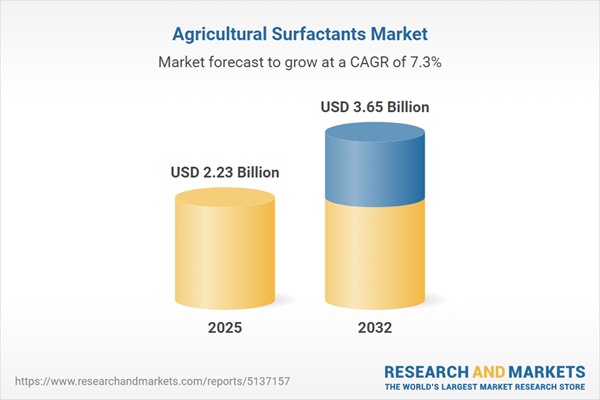Speak directly to the analyst to clarify any post sales queries you may have.
The agricultural surfactants market is experiencing robust transformation as advances in crop protection, sustainability imperatives, and regulatory change converge to drive new approaches in modern agronomy. Senior leaders now face a pivotal juncture, where improved yield, compliance, and environmental goals are fueling demand for innovative surfactant technologies.
Market Snapshot: Agricultural Surfactants Market Growth and Dynamics
The Agricultural Surfactants Market rose from USD 2.08 billion in 2024 to USD 2.23 billion in 2025. With a CAGR of 7.26%, it is on course to reach USD 3.65 billion by 2032. This growth is driven by heightened global demand for efficient, sustainable surfactant solutions as the sector increasingly focuses on innovation, regulatory compliance, and environmental stewardship. As agriculture technology evolves, senior decision-makers are re-evaluating surfactant choices to integrate with advanced crop management systems and environmentally responsible practices.
Scope & Segmentation
This report provides strategic insights by analyzing the agricultural surfactants sector across key segmentation layers, helping leaders tailor product and investment strategies for maximum impact. Regional and segment-specific detail supports precise opportunity targeting:
- Types: Amphoteric, Anionic, Cationic, and Nonionic surfactants. Each offers distinctive interfacial properties and is selected for optimal performance in key agricultural processes.
- Forms: Liquid, Paste, and Powder formats. Selection considers factors like storage efficiency, compatibility with various formulations, and ease of application in differing field conditions.
- Crop Types: Cereals and Grains, Fruits and Vegetables, Oilseeds and Pulses. Diverse crop requirements inform customization of surfactant technologies aligned to various agronomic conditions and growth cycles.
- Applications: Adjuvants, Seed Treatment, and Soil Treatment. Surfactants optimize processes from dispersion and emulsification to seed priming and soil conditioning, supporting broad adoption across farming methods.
- Regional Coverage: Americas (including United States, Canada, Mexico, Brazil, Argentina), Europe, Middle East & Africa (such as Germany, France, Saudi Arabia, South Africa), and Asia-Pacific (China, India, Japan, Australia, Southeast Asia). Each region faces different market drivers according to regulatory norms, farming scale, and environmental pressures.
- Key Players: Companies such as BASF SE, Bayer AG, Corteva Inc., Croda International, Akzo Nobel, Nufarm, and Solvay S.A. lead innovation, shaping industry standards for quality and adaptability in surfactant offerings.
Agricultural Surfactants: Key Takeaways for Decision-Makers
- Bio-based and multifunctional surfactant chemistries are increasing in adoption as sustainability and renewable sourcing become core to strategy and compliance.
- The integration of digital agronomy is influencing demand for surfactants engineered to perform under precision applications, enabling data-driven crop management and efficiency gains.
- Emphasis on environmental compliance is accelerating the shift towards low-toxicity, biodegradable surfactants, and fostering strategic partnerships with technology leaders to advance product development.
- Global supply chain strategies are adapting to the risks posed by volatile trade and procurement landscapes, requiring agile responses in sourcing and blending to ensure reliable supply and manage input cost variability.
- Adoption rates and product customization vary regionally, shaped by the combination of regulatory requirements, technical needs, and local climatic challenges. Leaders are exploring region-specific solutions to maximize uptake and user satisfaction.
Tariff Impact and Supply Chain Adaptation
Recent United States tariffs have introduced additional complexity across the agricultural surfactant value chain. Many manufacturers are revising operational models by relocating blending activities, forming new trade alliances, and striking a balance between domestic production and specialty imports. These strategic adjustments require comprehensive procurement planning and responsive supply chain management to maintain business resilience amidst fluctuating input costs. Decision-makers must monitor trade developments closely to optimize sourcing agility.
Methodology & Data Sources
This research draws upon a comprehensive methodology featuring secondary analysis from industry and regulatory sources, alongside primary interviews with executives and technical experts. The approach is underpinned by robust triangulation and expert validation to ensure credible, actionable findings suited for leadership decision-making.
Why This Report Matters
- Provides actionable analysis of regional trends, competitor strategies, and regulatory shifts essential for strategic decision-making in agricultural surfactants.
- Supports investment and product development decisions through structured, in-depth segmentation across surfactant types, application domains, and crop targets.
- Enables supply and procurement leaders to proactively manage risks, capitalize on growth opportunities, and align processes with evolving sustainability demands.
Conclusion
This report offers senior executives a clear guide to navigating the rapidly transforming agricultural surfactants market. By leveraging up-to-date insights on technological development, compliance demands, and supply optimization, organizations can strengthen their position and prepare for sector evolution.
Additional Product Information:
- Purchase of this report includes 1 year online access with quarterly updates.
- This report can be updated on request. Please contact our Customer Experience team using the Ask a Question widget on our website.
Table of Contents
3. Executive Summary
4. Market Overview
7. Cumulative Impact of Artificial Intelligence 2025
List of Figures
Samples

LOADING...
Companies Mentioned
The key companies profiled in this Agricultural Surfactants market report include:- Air Products Inc.
- Akzo Nobel N.V.
- Aquatrols Corporation of America Inc.
- BASF SE
- Bayer AG
- Brandt Co., Inc.
- CHS Inc.
- Clariant AG
- Corteva, Inc.
- Croda International plc
- Evonik Industries AG
- Garrco Products Inc.
- Helena Agri-Enterprises LLC
- Huntsman Corporation
- Kao Corporation
- Lamberti S.p.A.
- Loveland Products, Inc. by Nutrien
- Nouryon Chemicals Holding B.V.
- Nufarm Ltd
- Oxiteno S.A. by Indorama Ventures Public Company Limited
- Solvay S.A.
- Stepan Company
- The Dow Chemical Company
- Wilbur-Ellis Holdings, Inc.
- Unger Fabrikker A.S.
- Exacto, Inc.
- Sumitomo Chemical Co., Ltd.
- Kenvos AG
Table Information
| Report Attribute | Details |
|---|---|
| No. of Pages | 191 |
| Published | October 2025 |
| Forecast Period | 2025 - 2032 |
| Estimated Market Value ( USD | $ 2.23 Billion |
| Forecasted Market Value ( USD | $ 3.65 Billion |
| Compound Annual Growth Rate | 7.2% |
| Regions Covered | Global |
| No. of Companies Mentioned | 29 |









